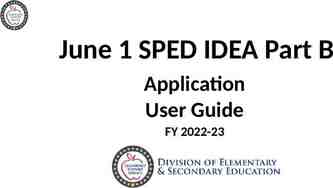Attachment, Complex Trauma and Behaviours that Challenge. Dr Cathy
29 Slides680.65 KB
Attachment, Complex Trauma and Behaviours that Challenge. Dr Cathy Harding Consultant Clinical Psychologist, Liberty Care , South Wales [email protected] SCLD August 2020
What do we mean by Attachment – An intimate relationship with a primary caregiver – It is as important as food, shelter as provides us with protection, comfort and support – Continues throughout lifespan. – We need our attachment system more when we are frightened. – As young children people work out how to make sense of behaviour and feelings dependent upon their care-givers – Allows you to form blueprints about how to see your self and others (internal working models).
– Children who are securely attached can rely on their caregiver to keep them safe and help them grow/develop. The learn their needs are important and others can help them. – Children who do not develop secure attachments are more likely to adapt their attachment behaviours to develop strategies to help them stay close to their parent without risking further distress or rejection. – They might be very suspicious or scared yet not use caregiver to seek support – Can lead to miscuing. – Children who receive frightening care will experience ‘disorganisation of attachment responses where they seem unclear how to interact- parents are both reassuring and frightening.
The impact of attachment disruption across the life span. Attachment Consistent, sensitive approach OR Dismissive, inconsistent responses Emotional regulation Ability to monitor and adjust the duration and intensity of emotional reaction. Over arousal and overwhelming and so the focus is on reducing on distress To cope with stress Empathy To think of the needs of others To use others for support. Theory of mind Pro- social behaviours
Secure attachment might be harder in Learning disability . – Evidence that the diagnosis of learning disability in itself changes the parental relationship – and alters the interaction of attachment. – High prevalence of Adverse Childhood Experiences – Risks of miscuing – Importance of secondary handicap (Sinasson, 1992) – “when our existence is reflected back to us tinged with contempt, disappointment, distance or not at all it has a profound effect on identity” Greenhill, 2011
Risks to attachment when you need life long support – Frequent changes in staff personal – High workload of staff – Discontinuity of staff presence – Limited opportunities for individual support – Organisational cultures which value independence from staff rather than mutual interdependence – Lack of support for paid carers in negotiating relationship boundaries.
Complex Trauma – Complex trauma usually over several occasions. Inds who should be trustworthy cause harm/abuse, neglect, interrupt emotional development through trauma (overwhelming the persons ability to cope). – People with learning disabilities are at a higher risk of early abusive life events and may have repeated experiences of abuse – People with learning disabilities are more often exposed to potentially traumatic events than people without learning disabilities, including: o sexual and physical abuse o bereavement o life-threatening illness or injury o Placements away from home/family/restraint
Coping with trauma – Not wanting to take a parental or disempowering stance or risk suggesting that people will a learning disability cannot be resilient (Wigham and Emerson, 2015) – Children with learning disabilities may have less coping strategies to help them deal with and make sense of the trauma: o o o o o o difficulties with problem-solving skills difficulties with verbal skills less sexual knowledge (financial knowledge) less understanding of what is appropriate or not appropriate behaviour of others less developmental clues to trauma less access to support, including on-line
Attachment, Trauma and Neurobiology
Click icon to add picture Understanding the Biology Neocortex – thinking brain Limbic system – emotional development Neocortex Diencephalon – Limbic system understanding of our Diencephalon bodies, movement, Brain stem eating control etc. Brain stem - basic fight and flight/freeze
Attachment, Trauma and Challenging behaviours
What might trauma present as? – Aggressive or violent behaviours – Self harm – Refusal to cooperate or disobeying commands – Withdrawal and sleeping at inappropriate times – Hypersensitivity – Sensation seeking – Task avoidance – Relationship avoidance – Extreme attention seeking – Poor social skills – Big reactions to small events. – Practice guidelines for trauma informed care and service delivery , Kezeler & Stravropoulos, 2012
What else you might notice – Poor turn taking – Talking too much – Lying - weird explanations – Not understanding some words or dissociation – Blaming others – Misreading facile cues – Difficulties with proximity/touch – Preferring younger games – Chaos within life, not learning from mistakes – Hard to get to know/feel close to – Odd reactions and behaviours. – “Playing” people against each other – Focus on immediate and not anting to talk about past – Unable to reflect on incidents – Compartmentalised memories – Disproportionate behaviour.
So, what do we know about attachment and behaviours that challenge. What we know is that; Attachment insecurity/disorganisation as a risk factor for family/placement breakdown and so consideration of this is needed in our formulations. Case series show that attachment based behaviour modification has superior outcomes to standard ABA – Considered the evidence from Schuengel et al 2011
Adults who have had attachment difficulties tend to: – Invalidate their own emotional experience – Be unable to consistently problem solve – Be unable to reward and nurture self – Have self hatred following failure to achieve goals – Experience shame for emotional vulnerability – Also specific coping strategies such as dissociation, self harm, shielding from shame and re-enactment which can occur.
What Dan Hughes says – “.develop a rigid sense of self reliance which becomes a compulsive need to control all aspects of their environment .caregivers much be controlled if the (person) is to keep themselves safe” (Hughes, 2004). Conference Jan 2016 in Edinburgh on YouTube
Blocking trust Young children block the pain of rejection by blocking the capacity for delight –as their experience is that the world does not give delight/comfort/joy – Intimidated by big feelings – Hypervigilance to emotionally arousing situations – Give up on learning new things – Have negative bias – Don’t know safety ques – Focus on objects/processions rather than relationships – Block off their inner life (so can seem very distant)
Blocked care – To protect against the rejection we block off the care – Defensive and not open – Focus on behaviours and not meaning – Reactive and not proactive – Repeat doing what is not working – Look to correct not connect.
Assessment – integrating attachment & PBS – Alan Skelly suggests: – Functional assessment of behaviour – Presence of insecure behaviour (MAST) – Account of the emotional responses to behaviour (ambivalence, hostility, loving contact?) – Assessing the conditions for security “what’s the last thing you did together/jointly “When was the last time you had a really good laugh together?”
Relational Risk Questions – Does the behaviour threaten to break, damage or stress-load our working relationship? – Do I feel hostile or ambivalent to the person I am working with? – Is an earlier pattern of rejection and relationship breakdown happening again? – Does the person seem fearful, unsure how to react to me, or show strange behaviours? – Do I feel emotionally unavailable to or cut off from the person?
Functions of behaviour Short term Longer term – Escape/avoidance – Loneliness – Attention – Control – Tangible – Power – Sensory – Self Esteem – Automatic Patterson, 2016
Relationships are important Promotion of positive, significant, enduring bonds with carers and others being a central goal of any intervention because without it there’s risk factor for placement breakdown – Body of research that shows that regardless of the model the relationship is at the heart of successful changes. – In non-learning disability literature increasing attention is being paid to the importance of trauma and early attachments in understanding adult distress.
Relationships are Important – and go both ways. – Challenging behaviour generate powerful feelings: engaging in a relationship with people regardless of this is important – These feelings exist in the here and now and over time – They can become barriers to empathetic relationships: if unshared they can ; lead to toxic cultures developing and make it hard to provide good enough care.
Attachment and PBS plans There are many ways to assess attachment and attachment behaviours, what matters most is that we consider it. Formulating in a way that helps to make sense of how the persons early experiences have lead to psychological vulnerabilities – relationships difficulties and ‘behaviours’ as a way of coping with these .to help make relationships more predictable. Each component of a PBS plan could include a statement about how this is helping the individual to form positive relationships and remove potential barriers to this (Skelly 2017). Attachment can be thought about within the PBS framework and how our primary, secondary and reactive strategies can help build attachments, mitigate against damaged attachments and repair when this occurs.
Risks of not considering attachment – Manage behaviour in short term but don’t think about emotional skill development – People increase the riskiness of behaviours and change the type of behaviour as the underlying need is not being met. – That staff are burnt out and so do not remain in post for long therefore further damaging attachment relationships. – Repeated breakdown of placement which again perpetuates the lack of attachments – Attachments can be used as an outcome measures to measure the success of PBS plans.
People need to be provided with good enough care which is reliable, containing, empathetic and attuned. (Hughes)
Key resources – Attachment and intellectual and Developmental Disability, Eds H.K. Fletcher, A Flood & DJ Hare – In cooperating Attachment Theory Into Practice: Clinical Practice Guideline for Clinical Psychologist working with People who have intellectual Disabilities. – The last frontier: Practice guidelines for treatment of Complex trauma and Trauma informed care and service delivery. – Taking time Framework: A trauma informed framework for supporting people with intellectual disability (NSW) – BILD Webinar re attachment and trauma and people with LD; https://www.bild.org.uk/attachment-difficulties-complex-trauma/ – A useful video re neurobiology https://www.youtube.com/watch?v 4-tcKYx24aA&feature youtu.be


































